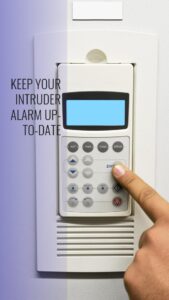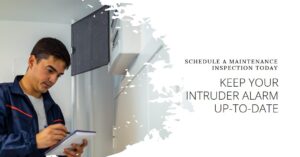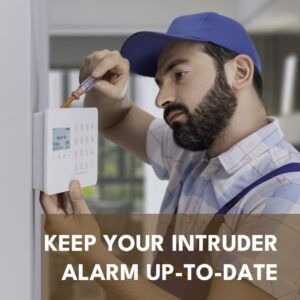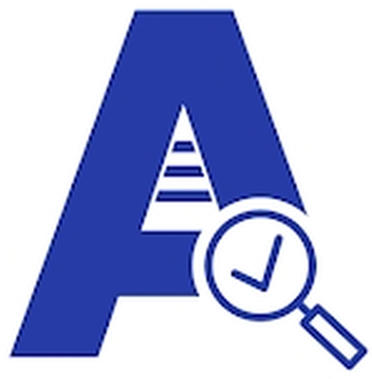Intruder Alarm Maintenance Checklist
By following Intruder Alarm Maintenance checklist and conducting regular maintenance, you can ensure that your intruder alarm system remains reliable and effective in protecting your property against unauthorized entry.
Maintaining intruder alarm systems is crucial for ensuring they function properly when needed. Here’s a checklist for intruder alarm maintenance:

Visual Inspection:
- Inspect the alarm control panel for any signs of damage or tampering.
- Check all sensors, detectors, and keypads for physical damage or obstruction.
Power Supply:
- Verify that the alarm system is receiving power from the mains supply.
- Check battery backup system and ensure batteries are functioning and fully charged.
Testing:
- Test the alarm system by arming and disarming it using the keypad or remote control.
- Test all sensors and detectors to ensure they trigger the alarm when activated.
- Conduct a full system test according to manufacturer’s instructions.
Sensor Alignment:
- Ensure sensors and detectors are properly aligned and positioned to cover the desired areas.
- Adjust sensor sensitivity settings if necessary to reduce false alarms.
Communications:
- Test communication pathways, such as telephone lines, internet connection, or cellular network, if the alarm system is monitored remotely.
- Verify that communication with the monitoring station is working correctly.
Software Updates:
- Check for and install any available software updates or patches provided by the alarm system manufacturer.
User Training:
- Provide training for users on how to operate the alarm system, including arming, disarming, and responding to alarms.
Documentation:
- Review and update system documentation, including user manuals, operating procedures, and emergency contact information.
Environmental Considerations:
- Check for environmental factors that may affect the performance of the alarm system, such as changes in temperature, humidity, or lighting conditions.
- Ensure that outdoor sensors and detectors are protected from weather elements.
Backup Plan:
- Develop a backup plan in case of power outages or communication failures, including alternative methods for monitoring and response.
Response Plan:
- Review and update emergency response procedures for intruder alarms, including protocols for contacting authorities and responding to alarm activations.
Record Keeping:
- Maintain detailed records of maintenance activities, including dates of inspections, test results, and any issues identified.
- Keep records of any repairs or upgrades performed on the alarm system.
Regular Maintenance Schedule:
- Establish a regular schedule for conducting intruder alarm maintenance, including routine inspections, testing, and documentation.

Using eAuditor Audits & Inspections for intruder alarm maintenance inspections can streamline the process and ensure thoroughness. Here’s a basic outline of features:

User Registration/Login:
- Allow authorized users (security technicians, facility managers, etc.) to create accounts or log in securely in eAuditor Audits & Inspections.
Dashboard:
- eAuditor Audits & Inspections provides a user-friendly dashboard where users can view upcoming inspections, past inspection reports, and maintenance schedules.
Alarm System Information:
- eAuditor Audits & Inspections checklist can include a section where users can input details about the alarm system, such as its location, components, and contact information for emergency responders.
Customizable Inspection Checklist:
- eAuditor Audits & Inspections allows users to create and customize intruder alarm maintenance inspection checklists based on the specific type and configuration of the intruder alarm system and includes pre-built templates for common inspection items.
Scheduled Inspections:
- eAuditor Audits & Inspections enables users to schedule regular inspections based on maintenance schedules or regulatory requirements and sends push notifications or reminders when inspections are due.
Guided Inspections:
- eAuditor Audits & Inspections provides step-by-step guidance for conducting inspections, including prompts for each checklist item and allows users to capture photos or videos as evidence during inspections.
Data Entry and Annotation:
- eAuditor Audits & Inspections allows users to input inspection data directly into the app, including notes and observations and can provide options for annotating photos or drawings to highlight specific issues.
Reporting:
- eAuditor Audits & Inspections generates comprehensive inspection reports with details of findings, recommendations, and any identified issues and includes options for digital signatures to certify inspection reports.
Issue Tracking and Resolution:
- eAuditor Audits & Inspections can allow users to track identified issues from inspections and assign tasks for resolution and can allow users to mark issues as resolved once they’ve been addressed.
Data Backup and Storage:
- eAuditor Audits & Inspections ensures that inspection data is securely backed up and stored and provides options for users to export reports or share them with stakeholders.
Integration with Other Systems:
- eAuditor Audits & Inspections can integrate with incident management systems for tracking and responding to alarms.
Feedback and Support:
- eAuditor Audits & Inspections includes a feedback mechanism for users to provide input on the app’s usability and features and provides access to customer support for assistance with app usage or troubleshooting.
